历史
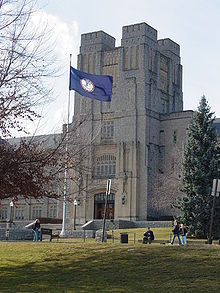
Virginia Tech's Burruss Hall.
In 1872, the Virginia General Assembly purchased the facilities of Preston and Olin Institute, a small Methodist school in rural Montgomery County with federal funds provided by the Morrill Land-Grant Colleges Act. The Commonwealth incorporated a new institution on that site, a state-supported land grant military institute called the Virginia Agricultural and Mechanical College.
Under the 1891–1907 presidency of John M. McBryde, the school organized its academic programs into a traditional four-year college. The evolution of the school's programs led to an 1896 name change to Virginia Agricultural and Mechanical College and Polytechnic Institute. The "Agricultural and Mechanical College" portion of the name was popularly omitted almost immediately, and the name was officially changed to Virginia Polytechnic Institute in 1944. During those years, there was a short-lived merger with Radford University which at the time was a women's college. In 1923, VPI changed a policy of four-year compulsory participation in the Corps of Cadets to two years.
VPI President T. Marshall Hahn, whose tenure ran from 1962 to 1974, was responsible for many of the successes that have shaped the modern institution of Virginia Tech. His presidential agenda involved transitioning the school into a major research university. To achieve this, the student body was increased by roughly 1,000 additional students per year, new dormitories and academic buildings were constructed, faculty were added (In 1966, for instance, the faculty added over 100 new professors) and research budgets were increased. During the Hahn Presidency the University saw its first Rhodes Scholar in W.W. Lewis, class of 1963. Hahn also ended the affiliation with Radford University, dropped the two-year Corps training requirement for its male students and allowed women to join the Corps. Virginia Tech was the first school in the nation to open its corps of cadets to women.
One of Hahn's more controversial missions was only partially achieved. He had visions of renaming the school from VPI to Virginia State University, reflecting the status it had achieved as a full-fledged research university. As part of this move, VPI would have taken over control of the state's other land-grant institution, a historically black college in Ettrick, Virginia, south of Richmond, then called Virginia State College. This plan failed to take root, and as a compromise, VPI added "and State University" to its name in 1970, yielding the current formal name of Virginia Polytechnic Institute and State University. In the late 1970s, the shorthand name "Virginia Tech" was adopted as the proper identification of the university's athletic teams over the acronym "V.P.I." and the media were requested to use "Virginia Tech" in their reporting of sport scores. In the early 1990s, the school authorized the official use of Virginia Tech as equivalent to the full VPI&SU name. Many school documents today use the shorter name, though diplomas and transcripts still spell out the formal name. Similarly, the abbreviation VT is far more common today than VPI or VPI&SU, and appears everywhere, from athletic uniforms, to the university's Internet domain name vt.edu.
In 2007, the school and campus received international attention as the site of the Virginia Tech massacre, which was the deadliest peacetime shooting incident by a single gunman in United States history, on or off a school campus.
学术
| Virginia Tech presidents |
| Charles Minor |
1872–1880 |
| John Lee Buchanan |
March 1, 1880–August 12, 1880 |
| Scott Shipp |
August 12, 1880–August 25, 1880 |
| John Lee Buchanan |
May 1881–1882 |
| Thomas Nelson Conrad |
1882–1886 |
| Lunsford Lindsay Lomax |
1886–1891 |
| John McLaren McBryde |
1891–1907 |
| Paul Brandon Barringer |
1907–1913 |
| Joseph Dupuy Eggleston |
1913–1919 |
| Julian Ashby Burruss |
1919–1945 |
| John Redd Hutcheson |
1945–1947 |
| Walter Stephenson Newman |
1947–1962 |
| T. Marshall Hahn |
1962–1974 |
| William Edward Lavery |
1975–1987 |
| James Douglas McComas |
1987–1993 |
| Paul Torgersen |
1993–2000 |
| Charles W. Steger |
2000–present |
Virginia Tech offers 80 bachelor's degree programs and 140 master's and doctoral degree programs in eight colleges:
- College of Agriculture and Life Sciences
- College of Architecture and Urban Studies
- College of Liberal Arts and Human Sciences
- Pamplin College of Business
- College of Engineering
- College of Natural Resources
- College of Science
- Myers Lawson School of Construction
- Virginia-Maryland Regional College of Veterinary Medicine
- Virginia Tech Carilion School of Medicine
Admission to study at Virginia Tech has become increasingly selective. Undergraduate applications to the school totaled over 21,000 for a targeted incoming class size of 5,000 students. Among accepted students, the average GPA was 3.94 and SAT was 1250. Admission into many graduate programs is also highly competitive. The Virginia Tech Carilion School of Medicine received over 1,200 applications for an incoming class size of 42.
In addition to its academic colleges, Virginia Tech also has a university-wide honors program known as University Honors. University Honors provides accepted honors students eleven different ways to earn honors credits towards one of the six honors degree options. A small percentage of University Honors students are also invited to live in one of the two honors houses, the Hillcrest Honors Community and the Main Campbell Honors Community. Honors students are required to maintain a 3.5 GPA in order to remain in the program.
On January 3, 2007 Virginia Tech along with Carilion Health System announced the creation of a new private medical school that will be a joint venture between the two organizations. The first class is scheduled to be admitted in 2009 for the 2010 academic year. The new medical school will have approximately 40 students per class, making it a very small medical school. It will be located in Roanoke next to the Carilion Health System hospital.
Rankings
In the U.S. News & World Report's “Best Colleges 2010”, Virginia Tech ranked 71st among national universities and 29th among public universities. In an earlier report, the Virginia Tech College of Engineering undergraduate program was ranked 14th in the nation (tied with Johns Hopkins and Northwestern) among all accredited engineering schools that offer doctorates and eighth among engineering schools at public universities. Six Virginia Tech undergraduate engineering specialties ranked among the top 20 of their respective peer programs (aerospace engineering, 10th; civil engineering, 7th; electrical engineering, 17th; engineering science and mechanics, 8th; environmental engineering, 9th; industrial engineering, 4th; and mechanical engineering, 14th). Its graduate Engineering program has been rated consistently among the first 25 in US, among all public and private universities. Over the years, it has built a strong reputation as a focal point for intensive research and innovative engineering.
The Pamplin College of Business undergraduate program was ranked 41st(2008) among the nation's undergraduate business programs and 24th among public institutions. Pamplin's overall ranking places it in the top 10 percent of the approximately 460 U.S. undergraduate programs accredited by the Association to Advance Collegiate Schools of Business International.
Virginia Tech was also recognized as having one of the top 14 cooperative education and internship programs in the nation.
Virginia Tech ranks in the top 20 public colleges and universities nationally among colleges that offer a first-class educational experience at a bargain price, according to Kiplinger's Personal Finance magazine.
Virginia Tech's endowment is known as the Virginia Tech Foundation, and as of 2007 total assets, gifts, and funds equal $524.7 million. Virginia Tech's operating budget for the 2009–2010 school year is $1.032 billion. The 2009-2010 budget represents a $20-Million increase from the previous school year.
The architecture and landscape architecture programs in Virginia Tech's College of Architecture and Urban Studies are ranked among the very best in America. In its 2010 "America's Best Architecture & Design Schools" report, DesignIntelligence (the only national college ranking survey focused exclusively on design) ranked the undergraduate architecture program 4th nationally among both public and private universities. The graduate architecture program ranked 8th in the nation. DesignIntelligence ranked the university’s undergraduate landscape architecture program No. 1 in the nation and its graduate landscape architecture program No. 2. (In addition, DesignIntelligence ranked the university's undergraduate interior design program 7th, and undergraduate industrial design program 11th.)
Programs in the College of Natural Resources consistently rank among the top of their type in the nation. The college's wildlife program is ranked first by its peers, and the fisheries program is ranked second. In a recently published study of the research impact of North American forestry programs, the Journal of Forestry ranked Virginia Tech's programs second on the perceptions-based composite score and third on the citations- and publications-based index. The wood science and forest products program is listed as an accredited program by the Society of Wood Science and Technology or SWST, and is recognized as one of the top programs in its category in North America. Virginia Tech is classified as a "RU/VH" (research university with very high research activity) under the Carnegie Classification of Institutions of Higher Education.
校园
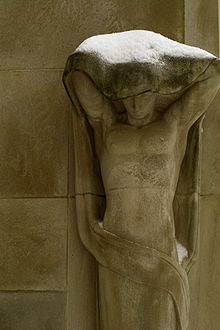
One of the War Memorial Chapel pylons "Sacrifice" on a snowy day.
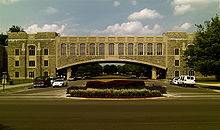
Torgersen Hall bridge over Alumni Mall. Torgersen is an example of architecture using Hokie Stone.
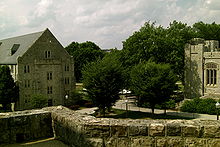
Eggleston and Owens Halls.
Main article: Virginia Tech campus
The Virginia Tech campus is located in Blacksburg, Virginia. The central campus is roughly bordered by Prices Fork Road to the northwest, Plantation Drive to the west, Main Street to the east, and US 460 Bypass to the south, though it has several thousand acres beyond the central campus. The university has established branch campuses in Hampton Roads (Virginia Beach), the National Capital Region (Northern Virginia Graduate Center Falls Church and Urban Affairs & Planning Program (Masters and Ph.D. in urban and regional planning) at its Old Town Alexandria, Virginia) campus, Richmond, Roanoke, and the Southwest Virginia Higher Education Center in Abingdon.
The Blacksburg campus is arranged rather uniquely in comparison to other universities. In the center of campus lies the Drillfield, which is a large oval field running Northeast to Southwest, encircled by a one way street known as Drillfield Drive. The Drillfield's name stems from its historical use by the Virginia Tech Corps of Cadets to conduct military drills. An underground river underneath the drillfield makes the land unsuitable for building, protecting it as an open space on campus. On the northwestern side of the Drillfield lies the majority of the academic and administrative buildings, including Burruss and McBryde halls. On the southeastern side of the Drillfield lies the majority of the residential buildings, including the residence halls, dining halls, and War Memorial Gym. Newman Library is located on the eastern side of campus and connects to Torgersen Bridge, which spans the main road into campus, Alumni Mall. North of the Drillfield and northwest of Alumni Mall lies the Upper Quad, known to many students as military campus. The Upper Quad is home to the Corps of Cadets' barracks and Shultz Dining center.
On the Blacksburg campus, the majority of the buildings incorporate Hokie Stone as building material. In fact, it is now official university policy that all new buildings must incorporate the stone into their design. Hokie Stone is generally gray, shaded by hues of brown and pink. The limestone is mined from various quarries in Southwestern Virginia, Tennessee, and Alabama - one of which has been operated by the university since the 1950s. However, while it is true that the majority of buildings on campus incorporate Hokie Stone into their design, there are a few notable exceptions. For example, all buildings in the Upper Quad, which includes Lane and Shultz Halls, are constructed of red brick. Also, a number of academic buildings were not constructed using Hokie Stone, as they were built before the institution of the rule mandating its use in all new university buildings.
In 2007 and 2009, Virginia Tech was ranked #1 by the The Princeton Review under the category of "Best Campus Food". It has seven dining centers which included Squires food court (Au Bon Pain & Sbarro), Owens Food Court, Hokie Grill (Chick-fil-A, Pizza Hut, Cinnabon), D2 & DXpress, Shultz & Shultz Express, Deet's Place, and the high end West End Market. Virginia Tech also has a catering center, Personal Touch Catering.
Panoramic view of Virginia Tech's Drillfield
体育运动
Main article: Virginia Tech Hokies
Virginia Tech's sports teams are called the Hokies, except for the swim team which uses a variant ("H2Okies", a play on the chemical formula for water). Tech teams participate in the NCAA's Division I in the Atlantic Coast Conference, which the school joined in 2004 after leaving the Big East. Along with all other ACC schools, Tech's football team competes in Division I FBS, the higher of two levels of Division I competition in that sport.
The Hokie Bird is a turkey-like creature whose form has evolved from the original school mascot of the Fighting Gobbler. While the modern Hokie Bird still resembles a Fighting Gobbler, the word "Hokie" has all but replaced Fighting Gobbler in terms of colloquial use. The term originated from the Old Hokie spirit yell, in which there was no particular meaning indicated for the word.
The stylized VT (the abbreviation for Virginia Tech) is used primarily by the athletic department as a symbol for Virginia Tech athletic teams. The "athletic VT" symbol is trademarked by the university and appears frequently on licensed merchandise.
During the early years of VPI, a rivalry developed between it and Virginia Military Institute. This rivalry developed into the original "Military Classic of the South," an annual football game between VMI and VPI usually held on Thanksgiving Day in Roanoke, Virginia. That series ended after the 1984 season; VMI had elected to play at the Division I-AA level, now Division I FCS, after the NCAA's 1978 divisional split for football, and the schools' wide disparity in size had led to a similar imbalance in results. Another long-standing and important rivalry is between Virginia Tech and the University of Virginia. The Virginia-Virginia Tech rivalry strengthened in concurrence with both UVA's and Tech's growth during the 1960s and 1970s and this is now the Hokies' primary program-wide athletic rivalry. The two schools compete in football for the Governor's "Commonwealth Cup" each season.
Virginia Tech's fight song, Tech Triumph, was written in 1919 and remains in use today. Tech Triumph is played at sporting events by both the Virginia Tech band, The Marching Virginians, and the Corps of Cadets' band, the Highty Tighties. The Old Hokie spirit yell, written in 1896 and used to this day, is familiar to many Virginia Tech fans. This chant is also where the word Hoki (since modified to "Hokie") originally appeared.
Virginia Tech baseball
Chuck Hartman, who retired as the Virginia Tech baseball coach in 2006, finished his career as the fourth winningest coach in Division I baseball history with a 1,444-816-8 record, including a 961-591-8 mark in his 28 seasons at Tech. Peter Hughes from Boston College is now the new coach for Virginia Tech.
Virginia Tech basketball (men's)
Main article: Virginia Tech Hokies men's basketball
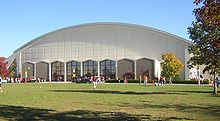
Virginia Tech's Cassell Coliseum
Virginia Tech's men's basketball team has seen a resurgence of fan support since the arrival of coach Seth Greenberg in 2003-04 and its entry into the ACC in 2004-05. Prior to Coach Greenberg's arrival in Blacksburg, the Virginia Tech men had not had a winning season since the 1995–1996 season when they received a bid to the NCAA tournament, and the team did not even make the Big East tournament its first three seasons in the conference. Greenberg's squad finally made the Big East tournament in 2003-04, then a year later scored their first postseason berth in nine years when they made the NIT in 2004-05 as a first-year ACC school. In the 2006-07 season, Greenberg's Hokies finished with a 10–6 record in the ACC and 22-12 record overall, earning its first NCAA tournament berth in 11 years, and reaching the NCAA second round before losing to Southern Illinois.
Virginia Tech basketball (women's)
Virginia Tech's women's basketball team, led by coach Beth Dunkenberger, is a fixture in postseason play, having received a berth to the NCAA tournament each season from 2003 to 2006. Virginia Tech's women have been in postseason play every year since the 1997-98 season, Bonnie Henrickson's first season as the head coach of the Hokies, earning seven NCAA berths and three NIT appearances during that stretch.
Both basketball teams play their home games in Cassell Coliseum.
Virginia Tech football
Main article: Virginia Tech Hokies football
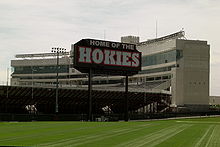
Lane Stadium from the north.
Virginia Tech's football team plays home games in Lane Stadium. Having a capacity of 66,233, it is relatively small in comparison to many other top Division I-A stadiums, yet it is still considered to be one of the loudest stadiums in the country. In 2005, it was recognized by rivals.com as having the best home field advantage in college football.
Head coach Frank Beamer has become one of the winningest currently active head coaches in Division I-A football with 198 wins following the 2006 season. Beamer's teams are known for solid special teams play (affectionately called Beamer Ball) and for tough defenses headed by defensive coordinator Bud Foster. The Hokies currently have the fourth longest bowl streak in the country, having participated in bowl games in each of the last 15 seasons. Since the 1995 season, the Hokies have finished with a top-10 ranking five times, won six conference championships (three Big East and three ACC), and played once for the national championship, losing to Florida State 46–29 in the 2000 Sugar Bowl. Currently Virginia Tech is one of only two teams to have 6 straight 10-win seasons in Division I-A football. Annually, Virginia Tech plays its traditional rival, the University of Virginia, for the Commonwealth Cup.
Virginia Tech soccer (men's)
Virginia Tech's men's soccer team has improved greatly since the arrival of Oliver Weiss, who has coached the team since 2000. Under Weiss, Tech has made four NCAA tournament appearances, including a trip to the College Cup in 2007. The Hokie's trip to the College Cup is the equivalent of men's basketball Final Four and was the soccer team's most successful season. The Hokies finished the 2007 regular season ranked third nationally.
Virginia Tech soccer (women's)
Women's soccer at Virginia Tech began in 1980 with two club teams under the guidance of Everett Germain and his two daughters, Betsy and Julie. Women's soccer has made great strides over the years and continues to be very successful.
Virginia Tech softball
Virginia Tech Softball made a name for itself by no hitting team USA in 2008 and advancing to the Women's College World Series for the first time ever.
Fight song
Tech Triumph is the fight song of Virginia Tech. It was composed in 1919 by Wilfred Pete Maddux (class of 1920) and Mattie Eppes (Boggs). Wilfred Preston ("Pete") Maddux, a trombone and baritone player in the Virginia Tech Regimental Band (member of the band from the Fall of 1917 to 1919), jointly composed Tech Triumph (1985 recording - link updated 2008) in 1919 along with Mattie Walton Eppes (Boggs). Mattie Eppes was a neighbor of Pete in his hometown of Blacksburg, Virginia. When he was home, Pete would often play violin with Mattie accompanying him on the piano. One evening in the summer of 1919, Pete asked her to help him compose a fight song for VPI. She played the tune and Pete wrote out the score and the words for two verses in a single evening. Pete Maddox is not listed in the yearbook with the band after 1919. Ms. Eppes later married John C. Boggs, Superintendent of Randolph-Macon Military Academy.
The song was first performed on Saturday, November 1, 1919, at the Fair Grounds in Lynchburg, Virginia before the football game between V.P.I. and Washington and Lee University. According to the report in the November 5, 1919, issue of The Virginia Tech, there were problems with obtaining uniforms for the entire Corps, so only the junior and senior classes, along with the band, were able to attend the game. The cadets arrived by train in Lynchburg at 11:30 a.m. and headed to the Carroll Hotel, which was V.P.I. headquarters. At 1 p.m., the cadets paraded through the streets of Lynchburg, then headed to the car barn to board street cars for the trip to the Fair Grounds.
"On arriving at the grounds, the battalion was formed for the review on the football field. After passing in review before the grandstand, the four companies formed a hollow square with the band in the center, and the band played our new song, 'Tech Triumph.'"
The following school year, as noted in the June 2, 1920, edition of The Virginia Tech, "After a great deal of trouble, to say nothing of the expense incurred, the Monogram Club has succeeded in placing the "Tech Triumph" upon a Columbia record, and we are told that the greatest college song on "record" will be out during Finals."
The popularity of the song continued, as reported in the November 3, 1920, edition of The Virginia Tech. "The song has been a great success, not only as a school song, but also as a popular selection, and is featured as such by many dance orchestras. J. N. Walker, who has been handling the sale of the records and piano copies for the Monogram Club, has received another supply of both the records and the sheet music, which are now on sale at 256 G Division. The price remains the same as formerly, $1.25 for the record and 35 cents for the piano copies. Anyone who has failed to obtain either the record or the sheet music is urged to do so at once, as the supply is not expected to last long."
[edit] Corps of Cadets
Main article: Virginia Tech Corps of Cadets
The Virginia Tech Corps of Cadets (VTCC) is one of only two military organizations established as an integral part of a major United States civilian, public university; the other is Texas A&M University. Both are Senior Military Colleges. The Corps of Cadets has existed from the founding the Virginia Agricultural and Mechanical College in 1872 and enrollment in the program was mandatory until 1964, when Virginia Tech first began allowing students to follow a strictly civilian track. The Virginia Tech Corps of Cadets has produced seven Medal of Honor recipients. Cadets live together in dormitories, march to meals in formation, wear a distinctive uniform on campus, and receive an intensive military and leadership educational experience similar to that available at the United States military academies. Unlike the US service academies, however, VTCC cadets are not required to engage in compulsory military service upon graduation, with as many as 20% of cadets in any given year electing to pursue a civilian career upon graduation.
Affiliated institutions
Domestic affiliations
Edward Via Virginia College of Osteopathic Medicine
Main article: Virginia College of Osteopathic Medicine
In 2003, Virginia Tech and the Harvey W. Peters Research Foundation worked together to start up a new private school of osteopathic medicine called the Edward Via Virginia College of Osteopathic Medicine (VCOM). VCOM opened in the Virginia Tech Corporate Research Center, an office park adjacent to and owned and operated by the university as a local business incubator. VCOM is incorporated as a private, non-profit institution with no state interest, but it is very closely affiliated with Virginia Tech on an operational level.
School of Biomedical Engineering and Sciences
In 2002, a biomedical engineering program, called the School of Biomedical Engineering and Sciences (SBES), was created as a cooperative venture between Virginia Tech and Wake Forest University. SBES offers opportunities to undergraduates and grants M.S. and Ph.D. degrees in biomedical engineering.
Virginia-Maryland Regional College of Veterinary Medicine
Main article: Virginia-Maryland Regional College of Veterinary Medicine
The Virginia-Maryland Regional College of Veterinary Medicine, founded in 1978, is a separate institution on the same campus, funded by the Commonwealth of Virginia and the state of Maryland and jointly operated by VT and the University of Maryland. VMRCVM and VT jointly operate an equine center in Leesburg, Virginia, and VMRCVM has a small operation on the University of Maryland's College Park, Maryland campus.
Virginia Bioinformatics Institute
The Virginia Bioinformatics Institute (VBI) is a premier bioinformatics, computational biology, and systems biology research facility that opened on the Blacksburg campus of Virginia Tech in 2000. It houses over two-hundred employees, multiple supercomputing clusters, and several DNA sequencers, including a massively-parallel high-throughput Roche GS-FLXsequencer. VBI is dedicated to the study of the biological sciences. The research platform of VBI focuses on the "disease triangle" of host-pathogen-environment interactions. By using bioinformatics, which combines transdisciplinary approaches to information technology and biology, researchers at VBI interpret and apply vast amounts of biological data generated from basic research to some of today’s key challenges in the biomedical, environmental and agricultural sciences. Work at VBI involves collaboration in diverse disciplines such as mathematics, epidemiology, computer science, biology, plant pathology, biochemistry, systems biology, statistics, economics and synthetic biology. The institute develops genomic, proteomic and bioinformatic tools that can be applied to the study of infectious diseases as well as the discovery of new vaccine, drug and diagnostic targets.
Virginia Tech Commonwealth Campus Centers
The Commonwealth Campus Centers offer continuing education and professional education programs, community outreach programs, customized contract courses, technical assistance projects, business, industry, non-profit or government-related research, and graduate education.
The Virginia Tech Hampton Roads Center located in Virginia Beach and serves the Hampton Roads community to the resources offered by Virginia Tech. The core mission of the Virginia Tech Hampton Roads Center is to provide educational opportunities and services, creating positive economic impact in the Hampton Roads region. Core concentrations are, Graduate Education Leadership Policy Studies, Principal Preparation, Engineering, Teacher education and Meeting and Event Planning.
Virginia Tech's National Capital Region offers more than 45 graduate degree and certificate programs taught by internationally recognized faculty. The university's two teaching locations, in Old Town Alexandria and at the Northern Virginia Center (NVC) in Falls Church, are both easily accessible by Metro. Some online courses are also available. Graduate degree and certificate programs including Architecture, Biomedical Technology Development & Management (joint degree with Georgetown Univ.), Business Administration, Civil and Environmental Engineering, Computer Science, Education, Electrical and Computer Engineering, English Language Program, Executive Master of Information Security Assurance, Government and International Affairs, Human Development, Industrial and Systems Engineering, Information Technology, Landscape Architecture, Marriage and Family Therapy, Natural Resources, Public Administration and Policy, Science and Technology Studies, Urban Affairs and Planning
The Northern Virginia Center is a part of Virginia Tech's Graduate School, and it is the home of several research and academic departments for Virginia Tech in the National Capital Region. It is located in Falls Church, Virginia, next to the West Falls Church Metro station.
Additionally, there are centers in Richmond and serving Central Virginia, Roanoke and the Virginia Tech Southwest Virginia Center serving Southwest Virginia and the Tri-Cities.
International Affiliations
Virginia Tech Center for European Studies and Architecture
The Virginia Tech Center for European Studies and Architecture (CESA) is Virginia Tech's European campus center and base for operations and support of its programs in the region surrounding Riva San Vitale, a small village in the canton Ticino in southern Switzerland. Housed in the 250 year old Villa Maderni, the Virginia Tech Center for European Studies and Architecture provides a varying degree of academic programs for the undergraduate and graduate students of Virginia Tech. The main offering of the center is its student residence program. In this program, students live in Riva San Vitale and attend classes in the Villa Maderni learning facilities and participate in field trips around Europe that pertain to the current lessons of the program. Other offerings of the center includes summer study abroad programs.
Virginia Tech Middle East and North Africa Program
Virginia Tech offers a graduate program at the Arab Academy for Science and Technology in the Egypt suburb of Abou Qir, Alexandria, Egypt. Masters and Doctoral degress are offered in Electrical (Communication) Engineering, Computer Engineering, and Computer Science.
Caribbean Center for Education and Research
The Caribbean Center for Education and Research (CCER) in Punta Cana, Dominican Republic was established as base for faculty and students to provide instruction and conduct research on biodiversity, environmental and social sustainability topics as well as and hotel and tourism management topics. The center makes use of a 2,000-acre natural forest reserve, a protected coral reef, freshwater lagoons and coastal mangroves through a partnership with the PUNTACANA Ecological Foundation and the PUNTACANA Resort and Club.
Non educational affiliations
Hotel Roanoke and Conference Center
Main article: Hotel Roanoke
Virginia Tech owns the Hotel Roanoke and Conference Center, which was donated to the university by Norfolk Southern in 1989. The hotel is managed by Doubletree Hotels, a division of the Hilton Hotels Corporation. Along with the Inn at Virginia Tech the Hotel Roanoke hosts high-profile investor / board of visitors meetings.
Virginia Tech Foundation
Main article: Virginia Tech Foundation
The Virginia Tech Foundation, Inc. was formed in 1948 to receive, manage, and disburse private gifts in support of the programs and missions of Virginia Tech. The Foundation is run as a 501(c)(3) corporation governed by a board of directors. The Rector of the Board of Visitors, the president of the Alumni Association, the president of the Athletic Fund, and the president of the University are all members of the Foundation board. The remainder of the board is composed members who are elected by vote of the boards existing members.
Subsidiaries of the Virginia Tech Foundation include Virginia Tech Corporate Research Center, the Hotel Roanoke, the National Public Radio affiliate WVTF Roanoke FM 89.1, the Center for European Studies and Architecture, and the Pete Dye River Course of Virginia Tech.
Alumni
Main article: List of Virginia Tech alumni
Research computing
Internet networking research is an important part of Virginia Tech's history. It has participated in Suranet, Internet2, Abilene, the Lambda Rail and other such networks. Virginia Tech also participates in the management of Net.Work.Virginia and the Mid Atlantic Crossroads.
In 2003, Virginia Tech created a supercomputer which ranked as the 3rd fastest in the world. The system was made from 1100 dual processor Power Macintosh G5s and cost US$5.2 million. The supercomputer, called System X, was disassembled shortly after it was ranked in order for it to be replaced with Apple's rack-based servers which consume both less space and power. Virginia Tech plans to have a second supercomputer running by the fall of 2008. The unit will be made of 324 Mac Pro Towers with a theoretical computing capacity of 29 teraflops.
更多
 |
Military of the United States portal |
 |
Virginia portal |
 |
University portal |
- Cassell Coliseum
- Early Music Ensemble at Virginia Tech
- Fighting Gobblers
- Hahn Horticulture Garden
- Lane Stadium
- List of forestry universities and colleges
- Preston and Olin Institute
- Virginia Tech Corps of Cadets
- Virginia Cooperative Extension
- Virginia Tech Hokies
- Virginia Tech massacre
参考文献
- ^ http://www.vtf.vt.edu/alumni_friends/message_from_coo.php
- ^ About the University | Virginia Tech
- ^ Kinnear, Duncan Lyle. "Pre-Founding: 1850–1872". A Short History of Virginia Tech, 1850–1974 (University Archives, Virginia Tech). http://spec.lib.vt.edu/archives/125th/kinnear/prefound.htm. Retrieved 2008-01-26.
- ^ "Thomas Marshall Hahn Jr., 1962-74". Life & Times of Virginia Tech Presidents (Virginia Tech). http://www.president.vt.edu/lt_hahn.php. Retrieved 2008-01-26.
- ^ "Thomas Marshall Hahn Jr., 1962-74". Life & Times of Virginia Tech Presidents (Virginia Tech). http://www.president.vt.edu/presidents/Hahn.html. Retrieved 2009-11-25.
- ^ "The Hahn Administration 1962-1974". A Short History of Virginia Tech (Virginia Tech). http://spec.lib.vt.edu/archives/125th/kinnear/hahn.htm. Retrieved 2009-11-25.
- ^ "Freshman Offers at a Glance". http://www.admiss.vt.edu/apply/freshman/what_do_we_look_for.php. Retrieved 2009-11-25.
- ^ "Hundreds apply for 42 medical school spots". http://www.roanoke.com/news/roanoke/wb/222670. Retrieved 2009-11-25.
- ^ "Best Colleges 2010". U.S. News & World Report. http://colleges.usnews.rankingsandreviews.com/best-colleges. Retrieved 2009-08-31.
- ^ "Best Undergraduate Business Programs". America's Best Colleges 2008 (U.S. News & World Report). http://colleges.usnews.rankingsandreviews.com/usnews/edu/college/rankings/rankbusiness_brief.php. Retrieved 2008-01-26.
- ^ "Virginia Tech Board of Visitors approves 2009-10 university budget". Virginia Tech News (Virginia Tech). http://www.vtnews.vt.edu/story.php?relyear=2009&itemno=462. Retrieved 2009-06-08.
- ^ http://www.swst.org
- ^ "Virginia Tech: Rankings & Lists". Princeton Review. http://www.princetonreview.com/college/research/profiles/rankings.asp?listing=1022823<ID=1. Retrieved 2008-01-26.
- ^ Lavender, David. "No place like home". Rivals. com. http://www.rivals.com/content.asp?SID=1014&CID=444097. Retrieved 2008-01-26.
- ^ "Hokies finish third in final postseason NSCAA/adidas National rankings". Virginia Tech Athletics. December 19, 2007. http://www.hokiesports.com/msoccer/recaps/20071219aaa.html. Retrieved 2008-01-26.
- ^ "Tech upsets US National Team, 1-0". 2008-03-26. http://www.hokiesports.com/softball/recaps/20080326aaa.html.
- ^ "Hokies advance to World Series with 6-1 win over Michigan". 2008-05-25. http://www.hokiesports.com/softball/recaps/20080525aab.html.
- ^ "History on the Founding of the College". Edward Via Virginia College of Osteopathic Medicine. http://www.vcom.vt.edu/general/history.html. Retrieved 2008-01-26.
- ^ "Virginia Tech - Middle East and North Africa Program". http://www.mena.eng.vt.edu/. Retrieved 2009-10-28.
- ^ "The Caribbean Center for Education and Research". Virginia Tech Office of International Research, Education, and Development. http://www.oired.vt.edu/CCER/. Retrieved 2009-10-28.
- ^ "About VTF". Virginia Tech Foundation. http://www.vtf.vt.edu/general/about.php. Retrieved 2007-07-02.
- ^ Foresman, Chris. "Virginia Tech building supercomputer out of 324 Mac Pros". Ars Technica. http://arstechnica.com/journals/apple.ars/2008/07/24/virginia-tech-building-supercomputer-out-of-324-mac-pros. Retrieved 2008-08-04.
External links
 |
Wikimedia Commons has media related to: Virginia Polytechnic Institute and State University |
- Official website
- Official VT athletics site
- DesignIntelligence "America's Best Architecture & Design Schools"
- A Short History of Virginia Tech, 1850–1974
- Collegiate Times (independent student newspaper)
- Website of the Commonwealth Campus Centers
- National Capital Region
- Northern Virginia Center
- Washington Alexandria Architecture Center



